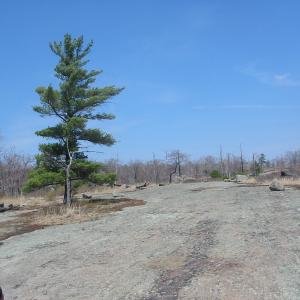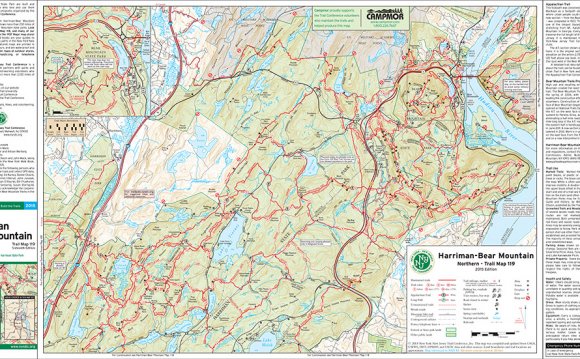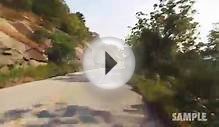 Description
Description
From the parking area, find the aqua-blazed Long Path, marked at the trailhead with a distinctive circular disk featuring the Long Path logo. Follow the Long Path along the north shore of the lake on a rocky footpath through a mountain laurel thicket. After about ten minutes, the trail bends away from the lake, crosses Pine Swamp Brook, and passes by an huge rock ledge to the right. A little over a mile from the start, you'll climb to a junction with the yellow-blazed Dunning Trail (laid out in 1933 by Dr. James M. Dunning, a volunteer with the Appalachian Mountain Club). The Long Path and the Dunning Trail run together for a short distance, then split at a fork. Take the left branch, now following the yellow blazes of the Dunning Trail along a wide woods road. As the trail descends through laurel, you will notice a number of charred and burned trees - the result of a forest fire that spread through this area in 2001. This was a "ground fire" - the live, mature trees were not destroyed. But the ugly scars of the fire can be seen along the trail for the next two miles. This should serve as a reminder for all of us to be careful with fire in the woods (in Harriman State Park, open fires are allowed only at the fireplaces provided at designated shelters). When you reach the base of the descent, you'll notice some stone foundations to the left of the trail. These are remnants of the village built in the late 1800s to house workers at the adjacent Hogencamp Mine. According to the late historian James M. Ransom, there were once 20 houses, several barns, a school and a store in this location! Iron ore was mined at this site from 1870 to 1885. After crossing a brook, you will observe a stone platform to the left. It was built out of tailings - the technical term for the pieces of rock discarded during the mining process. Piles of tailings may be found throughout this mining site. A short distance beyond, you will come to a vertical mine shaft, about 25 feet in diameter, on the right side of the trail. The shaft is filled with water, and a seven-inch cast-iron pipe (once used to dewater the mine) protrudes from it. Use extreme caution when approaching this open shaft! On the opposite side of the trail, iron rods may be seen protruding from a crumbling concrete base (now covered with grass), with a stone-lined well, three feet in diameter, beyond. There are many other interesting remnants of mining activity in the area. Those who wish to explore the area more extensively should consult
Iron Mine Trails by Edward Lenik, published by the New York-New Jersey Trail Conference (the hard-copy book is out of print, but the book is available from the Trail Conference website as an e-book). Continue south along the Dunning Trail, passing a swamp to the left. The trail soon curves to the right. One section of the old grassy road followed by the trail has been extensively built up using mine tailings. Part of this road was once known as the "Crooked Road, " as it follows many curves around the hills in an attempt to keep the road as level as possible. The lake visible to the left is Little Long Pond. After a mile on the Dunning Trail, you will come to a very large bare, rocky area, known as "Bowling Rocks" for the boulders that dot the bare rock. Then, in another 0.4 mile, after a short climb, you'll reach a junction with the red-on-white-blazed Ramapo-Dunderberg (R-D) Trail. (This junction, which is on the crest of a ridge, may be a little hard to find. If you find yourself beginning a long, steady descent, you've gone too far and should return to the highest point, where the junction is located.) Turn right and follow the red-on-white blazes northward. You are now at about the halfway point of the hike. The R-D Trail passes through an area where the scars of the recent forest fire are particularly noticeable. It crosses a huge open rock surface, known as the Whaleback. Just beyond, look for a plaque on a boulder to the right of the trail. It was placed in memory of George E. Goldthwaite, a member of the Fresh Air Club of New York, who was reputed to have hiked the entire 21-mile R-D Trail in less than five hours - quite a feat for hiking this steep, rocky trail! The trail now steeply descends a rock face to cross a stream on a log bridge, and it climbs to a junction with the blue-blazed Lichen Trail (which leaves to the left). A short distance beyond, the R-D Trail passes beneath a large overhanging rock, known as "Ship Rock" for its resemblance to the prow of a ship. The trail continues ahead to climb Hogencamp Mountain. The bare rock summit of this 1, 353-foot mountain - one of the highest spots in Harriman State Park - affords a wide panorama of the surrounding area. The tower visible straight ahead in the distance is a microwave relay tower for AT&T, located near Gate Hill Road. The trail makes a sharp right turn here and begins a steady descent, soon entering a deep evergreen forest. This is a welcome change from the open rocky expanses that you've followed for the last mile and a half. At the base of the descent, you'll reach "Times Square, " marked by a fireplace next to a huge boulder. It was so named because it is located at the junction of three trails and serves as a popular meeting place for hikers. Turn right here and follow the Arden-Surebridge (A-SB) Trail, marked by red-triangle-on-white blazes (to be distinguished from the red-dot-on-white blazes of the Ramapo-Dunderberg Trail). The A-SB Trail briefly runs together with the Long Path, but almost immediately bears left and begins a steady descent on an old mining road. In half a mile, it reaches the northern end of the yellow-blazed Dunning Trail, where it crosses a stream below an attractive cascade. This stream marks the northeastern end of the area damaged in the 2001 forest fire. Just beyond the stream crossing, you will notice a large rectangular cut in the hillside to the left of the trail. This excavation is part of the Pine Swamp Mine, another mining venture in the area, which was opened about 1830 and was worked intermittently until 1880. As you continue along the trail, several other excavations and open pits (now filled with water) may also be seen. One interesting feature, visible in the second excavation, is a long, round depression in the rock - the mark left by the drill bit used to excavate the mine! After passing these mine openings, the trail bears right and descends into the woods. Soon, you will pass a stone wall and several stone foundations to the left of the trail. These are remnants of the village that once housed the workers at the nearby mine. The A-SB Trail then passes by the northern end of the Pine Swamp and soon begins a steady ascent of Pine Swamp Mountain. After passing a junction with the Red Cross Trail, the A-SB Trail makes its final descent to the parking area at Lake Skannatati, where the hike began.

 Description
Description



 Description
Description

